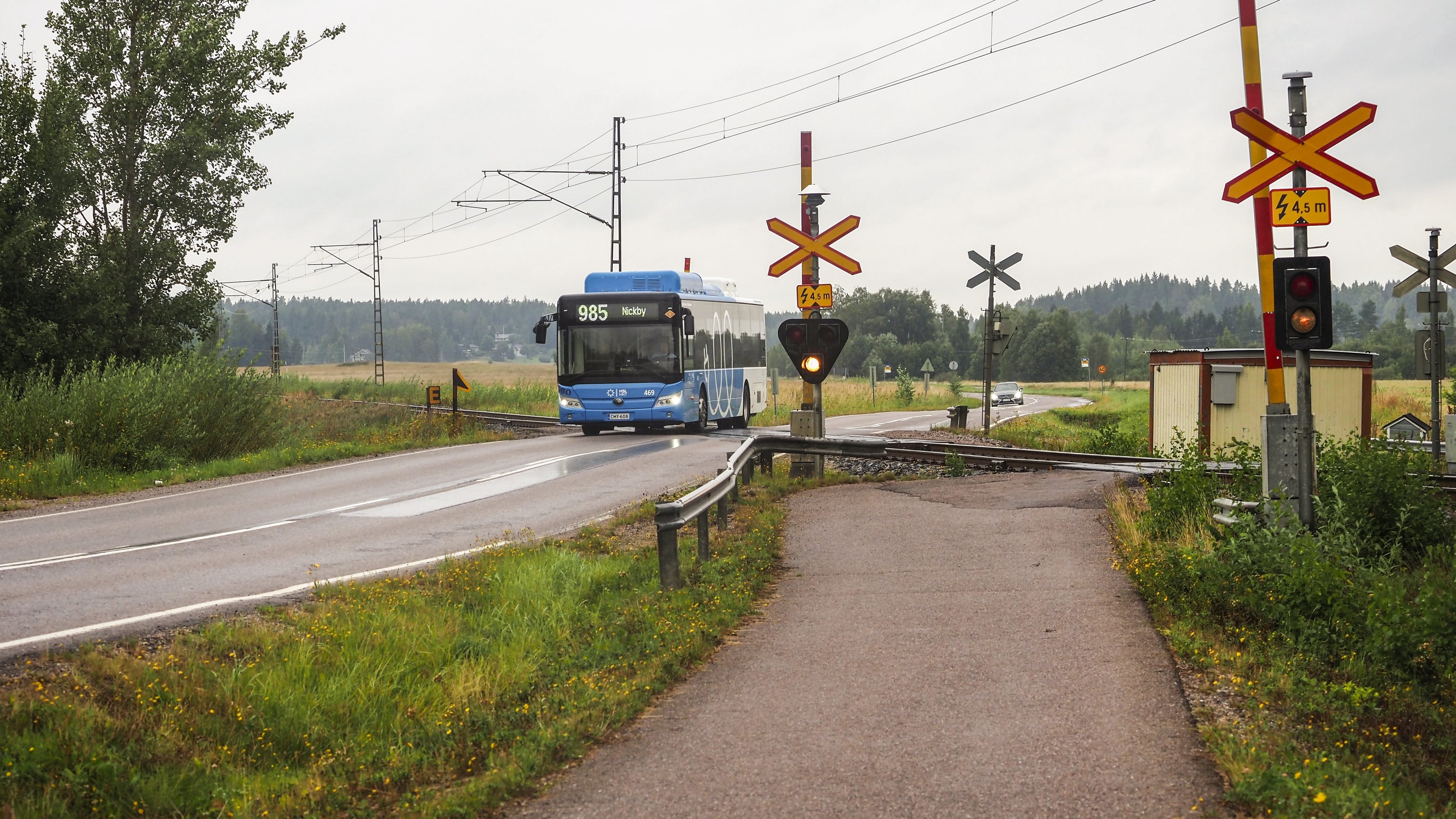Goal: Guarantee good health and well-being for people of all ages
In the Finnish Transport Infrastructure Agency’s work, this goal is approached through the target halve the number of deaths and injuries from road traffic accidents by 2030.
Mobility is an essential part of people's daily lives. The aim is to create a transport system in which human error does not lead to death or serious injury. Consequently, promoting traffic safety is a key part of sustainable development and, in particular, ensuring well-being and good health. On average, more than 200 people lose their lives and almost 900 are injured in road traffic in Finland each year. Over the past 10 years, we have lagged clearly behind the other Nordic countries in road safety development.
The EU’s longterm objective is ‘Vision Zero’, in other words reducing road deaths to close to zero by 2050. The backdrop to this is the Safe System approach: while not all accidents can be prevented, most deaths and serious injuries can be forestalled by pre-emptive measures, including safer infrastructure, road use and means of transport.

The Finnish Transport Infrastructure Agency plays an important role in promoting traffic safety, even if serious road accidents caused purely by the traffic environment are quite rare. Most accidents are the sum of several factors (including behaviour, traffic environment, conditions and the vehicle).
Together with the regional ELY Centres, the Finnish Transport Infrastructure Agency promotes road safety by maintaining the road network in good condition and improving it, with the aim of minimising the risks caused by the road. Assessing traffic safety impacts is an essential part of infrastructure asset management. Road safety work also includes many other forms of cooperation at national and regional level. Continuous road safety work in cooperation with other authorities and players covers, for example, transport system planning, land use planning, mobility management, traffic control and traffic information.
The earlier target of halving fatalities and injuries on the roads was set for 2010–2020. While the number of deaths on roads maintained by the Finnish Transport Infrastructure Agency decreased during the previous target period, this reduction was too slow considering that the target was halving the figures (2010–2020) (-21%). The number of injuries reported to the police has reduced considerably more and is close to the target (-41%).
In the future, traffic safety work will focus on road deaths and serious injuries, for which a similar target of halving the figures has been set for 2020–2030. Statistics on serious injuries have been based on the EU's common severity criterion in Finland since 2014. It should be noted that some serious injuries are excluded from statistics on road accidents known to the police, and no spatial data is available concerning them. While the new target period 2020–2030 is only beginning, the trend is promising in the light of accident numbers.
The National Road Safety Strategy for 2022–2026 directs national road safety work. To achieve the ambitious road safety target of halving road deaths and serious injuries in 2020–2030, determined action will be required. The Finnish Transport Infrastructure Agency actively participates in putting the strategy into practice. Among other things, the strategy stresses the importance of extensive cooperation between different administrative branches, knowledge-based decisionmaking and increasing the appreciation of traffic safety throughout society. The road safety measures for which the Finnish Transport Infrastructure Agency is responsible include
- Revising speed limit guidelines'
- Allocating funding to minor traffic safety measures
- Ensuring the traffic safety impacts of development projects
- Improving conditions for walking and cycling
- Developing automated surveillance.
It is estimated that the measures included in the impact assessment of the strategy will reduce road deaths by roughly 20 during the entire strategy period, of which measures targeted at the transport environment account for approx. 20%.
The Finnish Transport Infrastructure Agency plays an important role in implementing an amendment to the European Commission's Road Infrastructure Safety Directive. This amendment aims at improving road infrastructure safety and, in particular, reducing road deaths and serious injuries. The amendment expands the directive’s scope to roads, motorways, semi-motorways and main roads included in the TEN-T network as well as the main roads referred to in the Decree on Main Transport Routes, amounting to a total of 6,570 kilometres. To comply with this amendment, procedures must be updated and new ones defined.
The aim is to systematically and proactively analyse accident risks associated with road infrastructure, especially in order to assess the design characteristics of roads, engage in risk-based targeting of measures and monitoring and, in particular, take vulnerable road users into account.
Impact assessment and measurement
The Finnish Transport Infrastructure Agency aims to promote the achievement of the road safety target in its continuous work and through implementing the Road Infrastructure Safety Directive and the Road Safety Strategy in close cooperation with other actors. The impact of this will be of medium significance: while the impact of FTIA's measures over a ten-year period alone will be minor, the overall impact of high-quality infrastructure maintenance and measures taken in cooperation with other actors will be of major importance in upholding the current safety level, which will enhance the impact of FTIA's measures.
The goal is important and opportunities have been identified in this work, especially as a new strategy period during which a wide range of actors will be engaged is beginning. As threats are seen the uncertain global situation and scarcity of funding.
The Finnish Transport Infrastructure Agency will monitor progress towards the target based on road safety indicators:
- Annual numbers of deaths and serious injuries in road traffic
- Number of accidents resulting in personal injury
- Presence of traffic environment background risks in fatal accidents
- Risk of level crossing accidents.
As part of implementing the Road Safety Strategy and the Road Infrastructure Safety Directive, the progress of measures supporting target attainment will be monitored as follows:
- Road Safety Strategy: Completion of measures for which the Finnish Transport Infrastructure Agency is responsible; FTIA's involvement in measures carried out together with different actors.
- Implementation of the Road Infrastructure Safety Directive: the procedures required under the amendment have been described and their implementation is underway.
Achievements in 2023

According to preliminary data from 2023, 125 people lost their lives and 1,957 were injured in road accidents last year. The number of accidents resulting in personal injuries was 1,503. The trend in road traffic deaths has been in line with the target. In light of the accident figures, years 2022 and 2023 were exceptionally good. The target period has only just begun, however, and the challenge lies in keeping up the good trend. Nevertheless the figures are going in the right direction.
The following are examples of measures included in the Road Safety Strategy within the Finnish Transport Infrastructure Agency’s remit that were launched or completed:
- Development plan for automated traffic surveillance and a guide for designing, implementing and using traffic safety cameras
- Update of knowledge base for speed limit guidance
- Network-wide road safety assessment
- Report on observation errors at level crossings.
In addition, communication measures set out in the strategy were implemented, and the level crossing programme went ahead. The Finnish Transport Infrastructure Agency was also involved in promoting other measures in cooperation with different authorities and stakeholders.
The following measures were taken to implement the Road Infrastructure Safety Directive in 2023:
- Guideline updates required under the directive were made
- A network-wide assessment was launched
- Updated procedural description and instructions for periodical road safety inspections were introduced in new road maintenance contracts
- A background report on accounting for vulnerable road users was completed.
Level crossing programme in 2023

There are 2,468 level crossings on the state-owned railway network, 1,720 of which are unguarded. Level crossings are currently the most obvious risk on railways. On average, between 13 and 29 level crossing accidents continue to occur in Finland every year, with an average of five fatalities (average for 2010–2023).
However, the numbers of level crossing accidents and fatalities have clearly decreased. In 2022 and 2023, only 13 accidents occurred each year. One person died in 2022 and three in 2023.
The reasons for the improved traffic safety have included the Finnish Transport Infrastructure Agency's level crossing programme launched in 2018. In the course of this programme, 284 level crossings have been removed or improved on the state-owned railway network around Finland. Any sites where level crossings can be removed or improved in a smooth administrative process and at a low cost have already mainly been completed, and in the future, the level crossing programme measures will target the most hazardous and, consequently, more expensive and complex level crossing sites. All in all, the measures of the programme will concern around 600 level crossings.
Each year, EUR 15–20 million is allocated to improving level crossing safety through the programme. In addition, the Finnish Transport Infrastructure Agency implements other projects with separate funding to improve or remove level crossings.
Case: Fairway development at Inkoo gas terminal – speed and agility without compromising safety
Once the decision to locate the FSRU (Floating Storage Regasification Unit) in Inkoo was made, the Finnish Transport Infrastructure Agency had around six months to take measures enabling the safe arrival of the vessel and its subsequent refilling operations with LNGC (Liquefied Natural Gas Carrier) vessels of the same size. The dimensions of these vessels are significantly larger than those for which the fairway was designed. A significant factor in ensuring safety was that extensive improvements to the fairway could not be launched before a permit referred to in the Water Act was obtained. Obtaining this permit was not possible on the given schedule.
The safety measures were based on significantly improving and developing existing fairway markers in cooperation with vessel pilots and the captains of tugboats that assist the vessels. The fact that the markers had to serve both the refilling vessels and the tugboats assisting them added to the challenges of the planning work. To respond to this challenge, both better markers and the planning and testing of shipping operations in a vessel simulator were required. Resorting to unusual markers was partly also necessary in order to ensure vessel safety.
An experienced expert group was put together with representatives of the aforementioned parties as well as officials of the Finnish Transport Infrastructure Agency and Traficom to plan and carry out the safety measures. The group tested the effectiveness of different marker options while also practising the actual shipping operations in a simulator. Developing and ensuring clear and unambiguous communication for shipping operations was also important.
Practice helped to identify procedures by which the safety of vessel operations could be ensured in sufficiently good conditions, and to develop solutions by which fairway markers meeting the operative requirements could be developed.
For winter navigation, preparations were made for using those vessels in the icebreaker fleet that have the most suitable capacity to assist safe gas transports to Inkoo. The icebreakers Fennica and Nordica are equipped with rudder propellers, and they are able to produce a wide and clean channel for LNG gas vessels, enabling the safe transport of gas to the terminal.

Case: Stay off the track campaign
The Finnish Transport Infrastructure Agency uses various means to promote railway safety. In recent years, communication about the hazards of railways targeted at different groups has been stepped up on a range of channels. The Stay off the track campaign, which was already launched in late 2022, continued in 2023. The campaign's core target group is children and young people (aged 13 to 24) who were reached through various social media channels.
The key channels used were TikTok, YouTube and Instagram. The core message of the Stay off the track campaign is that when you step on the track, you will always be the loser. As part of the campaign, young people could try their luck by playing a free animated game. Cooperation with two TikTok influencers was also resorted to as part of the marketing efforts, which brought plenty of additional visibility to the campaign.
While the social media has been the most important channel for the target group, the campaign also attracted a high level of attention in the national media in 2022, including Helsingin Sanomat newspaper and Finnish Broadcasting Company’s channels. The 2023 campaign reminded many TikTok users of the lessons learned during the previous one. Young people are a challenging target group, but the figures indicate that the railway safety campaign was a success.